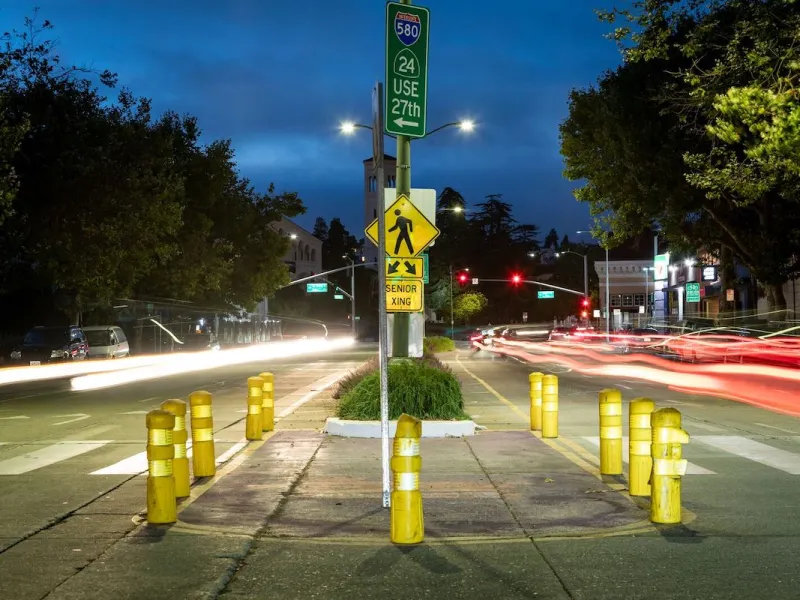Speeding drivers who swerve into the bus-only lanes on International Boulevard, dangerously passing other vehicles, have become a daily problem since the construction of the road’s bus rapid transit stops several years ago. Now the city says it’s doing more to try to deter this behavior.
On Tuesday, the City Council increased funding for car-slowing speed bumps in the bus lanes, bollards, paint, new signs, and potentially other infrastructure. This is the latest move by the city to try to improve road conditions on International.
The council originally approved the “quick-build project” sixteen months ago in cooperation with AC Transit, which operates the rapid bus line. Tuesday’s decision by the council increases funding by $587,000 for the safety upgrades, for a total project cost to the city of $1.85 million.
Learn more about the kinds of infrastructure used to make roads safer
AC Transit will also contribute $400,000 from a “quick strike” grant from the Metropolitan Transportation Commission to help pay for work on International Boulevard.
OakDOT and AC Transit announced their plan to add the speed bumps to the “quick build project” last week in a press release. The bumps will cover parts of the boulevard from 14th Avenue to 107th Avenue. Other agencies that serve the arterial road, including the Oakland Fire Department, Oakland Police Department, and the Alameda County Sheriff’s Office, were involved in the discussion of adding these bumps.
“Oaklanders living, working, and shopping along International Boulevard deserve a safe and vibrant corridor. That is why I am committed to working in partnership with Fruitvale merchants and community organizations to address public safety in a holistic manner,” Oakland Mayor Sheng Thao said about the project.
The bumps are known among transportation engineers and planners as “speed cushions” or “tables.” The tables have cut-out spaces the size of bus tires so that AC Transit’s buses and emergency vehicles can easily drive over them without being jolted. While drivers illegally using the bus lane could also avoid a jolt by aligning their tires with these channels, research by Oakland and other cities has shown this is actually quite difficult and that speed cushions make it less likely that drivers will reach the same high speeds.
Long one of the city’s most dangerous roads, International has seen a rise in collisions since the addition of the dedicated bus rapid-transit lane in the summer of 2020. Some drivers illegally use the lane to bypass slower traffic and run red lights. According to the city, one-third of all traffic deaths in Oakland occur on or around International.
The new safety project will see AC Transit and OakDOT add bollards to separate the road’s vehicle lane from the bus lane to discourage bypassing. New signage highlighting speed limits is also expected.
AC Transit and OakDOT staffers say the new project is expected to be completed this year.
“International Boulevard continues to be a critical focus for city resources because, despite significant safety improvements incorporated along the corridor as a part of AC Transit’s Tempo Bus Rapid Transit (BRT) service, severe and fatal crashes, and dangerous driving, including speeding, red light running, and bus lane violations persist,” Megan Wier, the acting director for OakDOT, wrote in a report earlier this month.
AC Transit CEO Michael Hursh said in a press release last week that the rapid bus line has reduced riders’ commutes from San Leandro to downtown Oakland from two hours to 50 minutes. As a result, the agency wants to implement the new street safety infrastructure without slowing down their buses.
Oakland road safety advocates have previously pointed out that AC Transit’s original plans for International Boulevard included safer infrastructure such as separating barriers at intersections. This was not included when the project was built but advocates say it would have greatly reduced illegal speeding.
Traffic Violence Rapid Response, a road safety advocacy group, has produced two reports in the last two years documenting the problems on International and offering possible solutions. The group’s first report, which they submitted to OakDOT in 2022, found that illegal left turns and speeding were the leading cause of collisions on the road. It also noted that bus rapid transit systems in Jakarta, Indonesia, and Mexico City, Mexico, use concrete and plastic hard strips on the ground to stop drivers from illegally occupying bus lanes.
“Speed cushions are an important step along International but we must speed up the evaluation process. One month after speed cushions go in, there should be an analysis of the speed of traffic near the cushions, and a comparison to the speed of traffic before the cushions were installed,” Kevin Dalley, a volunteer with the activist group said. “The current plan is to wait about six months before the evaluation is performed. Every month we wait risks the loss of additional lives.”
Some Oakland residents said online that they believe the speed cushions won’t significantly reduce speeding and collisions on International, even though research has found elsewhere that it can make a difference.
“Without traffic enforcement, this is meaningless,” a Fruitvale resident tweeted.
Others are glad changes are coming but are angry it’s taken so long.
“This is great news, but too many people had to die over years for this ‘quick’ fix,” Tommaso Boggia, a local web developer, tweeted.


